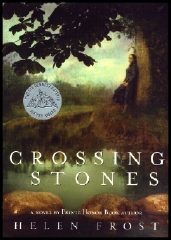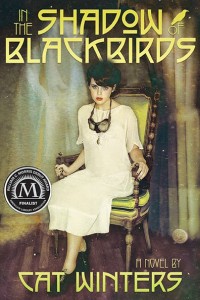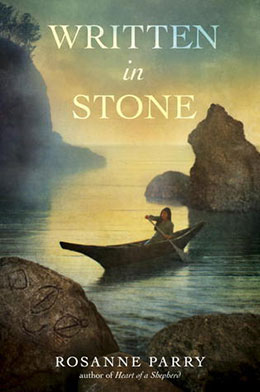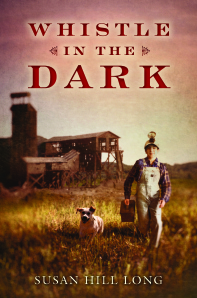Not a presenter, and really looking forward to spending time with my favorite writers in a beautiful place.
Tag Archives: writing
Middle Grade Monday book review: The Great Trouble by Deborah Hopkinson
I’m going to try to read all the books that are on the 2015-16 OBOB list with me and I’m so happy to start with a wonderful book by my friend and fellow Portlander, Deborah Hopkinson. This is a story after my heart because epidemiology was my 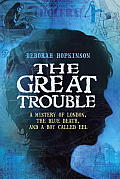 mother’s field. It’s an account of how the enterprising Dr. Snow and a couple of street urchins proved that a cholera epidemic that a broke out in Victorian London was caused not by the heavily polluted air but by the contaminated water in the Broad Street pump.
mother’s field. It’s an account of how the enterprising Dr. Snow and a couple of street urchins proved that a cholera epidemic that a broke out in Victorian London was caused not by the heavily polluted air but by the contaminated water in the Broad Street pump.
Three things for a kid reader to love:
1. Any kid who lives Bones or CSI or other tv crime scene procedurals will love this. It’s full of real nitty gritty details of how to prove that disease is water-borne when the water tastes fine and the air stinks. Great fun, and not “teach-y”
2. Cool historical maps of the epidemic are in the back matter. Love Maps!
3. The narrator, a kid who goes by the name Eel, is appealing and keeps the events on a very human scale. In finding and answer to the riddle of the Broad Street pump, Eel finds a home and protection and education for his beloved little brother.
Something for the writer to think about:
Any story about an epidemic is going to be tragic and this one doesn’t shrink from death. However, and this is the important distinction to me, it doesn’t revel in death or glamorize suffering. It’s a fine line to walk and I think it’s handled beautifully. Well worth a read just to see how Deborah gets the balance just right.
Also I’m going to tag this as a diverse book in terms of class. It addresses very directly the injustices Eel faces because of his economic status. It’s easy to over-look or romanticize the poor. Here’s a book that in my opinion does them justice. The low-income characters are a mix of good and bad actors and the upper-income characters are an equally mixed bag in terms of personal virtue. Bravo!
To #%*& or not to *&^%$#: Swearing in Middle Grade Fiction
The expectations for the use profanity in children’s fiction are pretty clear. It’s commonplace in YA novels and completely absent in picture books and easy readers. But middle grade fiction takes the middle ground. Is swearing okay in a middle grade book? Well, it’s complicated. The issue is balancing authenticity with respect for your audience. Everybody encounters profanity; it is a language intensifier and can be useful in conveying the weight and reality of your characters situation. And yet it is the nature of profanity to offend, so any use will have consequences in how the book as a whole is received.  As a practical matter MG books with profanity tend to be shelved with YA no matter how young the character is. This is not necessarily a problem, To Kill a Mockingbird and it’s 9 year old protagonist Scout have been doing just fine in the YA section of the library for the last five decades. Even so any use of profanity should be carefully considered. When I’m confronted with an opportunity to use a swear word in my novels, here are five choices I consider.
As a practical matter MG books with profanity tend to be shelved with YA no matter how young the character is. This is not necessarily a problem, To Kill a Mockingbird and it’s 9 year old protagonist Scout have been doing just fine in the YA section of the library for the last five decades. Even so any use of profanity should be carefully considered. When I’m confronted with an opportunity to use a swear word in my novels, here are five choices I consider.
Every time I use profanity I rewrite the scene with out it, let it sit for a day or two and read the result out loud. I have been surprised by how often the scene was stronger without the swear word. Sometimes profanity is just a habit of the author and not integral to the character’s worldview or the movement of the plot.
- Reduce
 My editor once told me that swearing is loud on the page in a way that it is not in real life. I think of it as the equivalent of yelling or texting in all caps. As the mom of many I can tell you yelling is most effective when used sparingly—usually when lives are at stake. I think the last time I actually yelled at home was when someone’s sleeve caught on fire while roasting a marshmallow. Because swearing functions as an intensifier, it’s power is diluted by overuse. If I am working with a character who would naturally swear a lot, I’ll run a word search and see if I can limit the swearing to places where it will have the most impact.
My editor once told me that swearing is loud on the page in a way that it is not in real life. I think of it as the equivalent of yelling or texting in all caps. As the mom of many I can tell you yelling is most effective when used sparingly—usually when lives are at stake. I think the last time I actually yelled at home was when someone’s sleeve caught on fire while roasting a marshmallow. Because swearing functions as an intensifier, it’s power is diluted by overuse. If I am working with a character who would naturally swear a lot, I’ll run a word search and see if I can limit the swearing to places where it will have the most impact.
Sometimes you can duck the issue when the swearing is done by a non-viewpoint character. When I was working on Second Fiddle I knew that the moment that the girls discovered that they were all alone in Paris with no money, no passports and no return train tickets, any normal eighth grader would swear. But my main character wasn’t really the swearing type. Instead, I had her report that her friend said every swear she knew in English and then moved on to exhaust her supply of swear words in French and German. This preserved the authenticity of the scene without getting into a specific swear word.
- Substitute
Here is one of the more entertaining devices of MG fiction. Most kids get in trouble for swearing, and yet they have the same need for the occasional language intensifier as everyone else. So kids are great at making up substitutes. It’s the “drat, darn, and golly” solution, and it has great comic potential.  The advantage to a curse word substitution is that it can also serve to convey information about the character and setting and lighten the mood of an otherwise tense situation. We had a fascinating conversation at a bookstore event recently with some women who wrote adult mysteries. There is an expectation in adult cozy mysteries that swearing is omitted so this author had her spice shop owner detective say things like, “Well that just frosts my chili peppers!” I had no idea such rules extended to the world of adult books.
The advantage to a curse word substitution is that it can also serve to convey information about the character and setting and lighten the mood of an otherwise tense situation. We had a fascinating conversation at a bookstore event recently with some women who wrote adult mysteries. There is an expectation in adult cozy mysteries that swearing is omitted so this author had her spice shop owner detective say things like, “Well that just frosts my chili peppers!” I had no idea such rules extended to the world of adult books.
- Commit
There are circumstances in which the first four choices are wrong for the voice of the character or the gravity of the situation. And in those cases swearing maybe appropriate. Freedom of Speech means nothing if we never use it, and if you have used profane speech appropriately in your book you will find both people who passionately attack any use of profanity and those who just as passionately defend your right to tell the story as you must, free of censure. I opted to use swearing to a very limited extent in Heart of a Shepherd, having considered and discarded the above considerations, and it has done no harm whatsoever to the book. It was warmly received, sold well, and was carried by Scholastic Book Clubs. A few libraries don’t shelve it in k-4 schools. I really have no argument with that. Most teachers who read it aloud chose to skip or modify the swear word in the classroom. No argument there either. On the other hand, many teachers and parents have told me that because they weren’t expecting profanity in a middle grade book, it gave them a good opportunity to discuss where profanity is socially acceptable and not, and what it was about that particular scene that made a character swear when he ordinarily wouldn’t. In my opinion that’s a conversation worth having.
I’d love to hear what other people consider when making decisions about profanity, both in terms of writing and in terms of sharing books with middle grade kids as a parent or teacher or librarian.
Learning to Love your Book-alikes
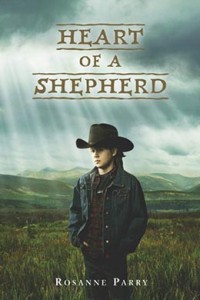
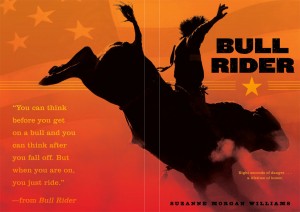 When my very first book Heart of a Shepherd came out back in 2009 I met Suzanne Morgan Williams from the Class of 2K9 marketing group whose book Bull Rider was astonishingly similar to mine. It was all the more surprising because they were western stories about ranching families with family members deployed to the Middle East. Not exactly the most crowded genre. It was very tempting to think of this as a disaster, a head to head competition, a diminishment of what I had worked so hard on. But my husband pointed out that selling a book is not like selling a car. It’s not like a person buys a book and then doesn’t need another for 5 to 10 years. A very helpful perspective. The beauty of the book business is that the more people read good books the more they want new good books.
When my very first book Heart of a Shepherd came out back in 2009 I met Suzanne Morgan Williams from the Class of 2K9 marketing group whose book Bull Rider was astonishingly similar to mine. It was all the more surprising because they were western stories about ranching families with family members deployed to the Middle East. Not exactly the most crowded genre. It was very tempting to think of this as a disaster, a head to head competition, a diminishment of what I had worked so hard on. But my husband pointed out that selling a book is not like selling a car. It’s not like a person buys a book and then doesn’t need another for 5 to 10 years. A very helpful perspective. The beauty of the book business is that the more people read good books the more they want new good books.
And the really terrific thing was getting to know Suzanne and working together to promote our books because we’ve found that if a reader likes one of our stories, they will probably like the other. They aren’t identical books after all. The main character in Suzanne’s story is a little bit older. Heart of a Shepherd is about the experience of having a deployed parent. Bull Rider is about the experience of having a brother return from war with a traumatic brain injury. We’ve done joint book store appearances, spoken together on panels and in workshops at writers conferences, and even sold our books together at the Reno Rodeo. And much to our mutual delight these books have flourished side by side.
But I’ve also known people who’ve worked for months, years even, and seen a book published which is very similar to their own manuscript, and then decided to drop their own project completely. It’s such a shame because there is often plenty of room for multiple

books on a topic. I think of them as “book-alikes” and in some ways they can be an asset to your own work. If somebody has written a book similar to mine then it’s a great strategy to encourage my book to be grouped in with a similar book. Often teachers are looking for several books from a historical era so that there will be something to suit every reading level in her class. Many bookstores prefer to host multi-author events. The picture to the right is myself and Elizabeth Rusch (dressed as Nannerl Mozart) and Virginia Euwer Wolff. We are doing an event which drew dozens of vocal and instrumental performers and lots of families to a community center to celebrate our three music-themed books: Virginia’s Mozart Season, an absolute classic YA story of a girl preparing for a music competition, Liz’s picture book biography For the Love of Music about Mozart’s big sister, and my middle grade novel Second Fiddle.
I’ve learned to love my Book-Alikes over the years and have become good friends of people whose books are similar to mine. And in celebration of that here are four books who like my story Written in Stone are set in America in the early part of the 20th century. They are Crossing Stones by Helen Frost, A Whistle in the Dark by Sue Hill Long, Born of Illusion by Teri Brown and In the Shadow of Blackbirds by Cat Winters.
The Retrospective Outline
To outline or not to outline
If you are looking to start a quarrel (or at least a passionate debate) in an MFA creative writing program, the topic of outlining is a winner every time. Having never taken an creative writing class or alas, even majored in English, I came to the debate late in the game and without a horse in the race. I believe that in the end each writer finds her own way, and no one system works for every writer. That said I think I have finally hit upon an outlining strategy that works well for me. I think of it as the Retrospective Outline. I’ve always intuitively resisted the initial outline as stifling but I know that sooner or later the structure of story needs attention, so I’ve taken to doing the outline after a full first draft is finished.
I finished a draft right before Christmas. It’s a story I’ve been working on for a while. Like a lot of writers I’ve heard from over the years, I’m better at beginnings and endings than middles. It’s very easy to lose focus in the middle and either write more scenes than you really need or not quite enough leaving gaps in the narrative. A friend recommended the screenwriting book Save the Cat and since I hope to write a screenplay in the next few months I thought I’d give it a try. Screenwriter Blake Snyder is a big advocate of laying out an entire movie in scenes, a note card for each scene. The scenes are put on a cork board, a row of cards for each of three acts, and rearranged or discarded as necessary. I was a bit skeptical at first but my studio has a lovely long empty wall painted in my favorite shade of red, so I gave it a try using post-it notes.
Drama in 3 Acts!

When I first laid out my scenes it became immediately obvious that the second half of the second act was where the trouble resided. All the other sections had 7 to 10 scenes and the second half of the the second act had 16 scenes. Aha!
Then once I had an idea of where to look I went through each scene with an eye to which ones had strong conflict, and propelled the main character forward. It became pretty obvious which scenes were just there to convey information, had no inherent conflict, and took the focus off my main character and his journey.
But wait there was vital information in those scenes–not so much drama but stuff you have to know! That’s the hard part of of trimming your work, not letting go of a perfectly good scene that doesn’t serve the plot, but figuring out what to do about the bits of information. I ended up putting the info on a smaller post-it and finding a different scene where I could weave it in. The best part about the process was learning that really in the 5 scenes I cut, I only had 4 vital pieces of story information that eventually found a home early in the second act.
Integrating the Visual elements of a story
This particular book has a visual element–completely new ground for me. I added smaller blue post-its for the scenes that have an illustration. In an earlier draft the first illustration didn’t come until mid-way through the second act. (Pink is act 1, green is the two halves of act 2, and purple is the 3rd act.) It was clear in looking at the book as a whole that the 12th scene was too long to wait for a visual so I found a way to put one in the 3rd scene of the story. But then as I was working a really strong idea came along for a final image at the very end of the story, so I decided to look for a way to put an echoing image in the first scene. The result (I hope) is a much more balanced story.
So there you have it! One method for outlining a story. Maybe not everyone’s cup of tea but it helped me trim about 6,000 words that were not doing my story any good.
If your new year’s resolutions happen to include writing a novel for kids or teens, I’ve got a class starting up at the Loft Literary center. My Vampire-Free Fiction class starts the 20th of this month. You can get lots more information here




